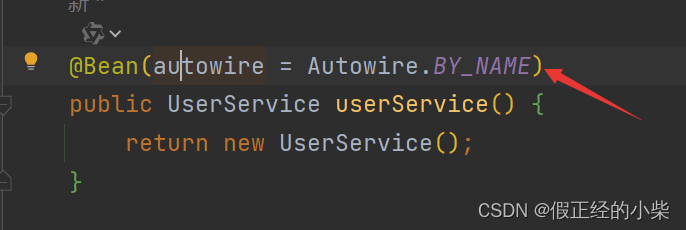【Spring源码分析】从源码角度去熟悉依赖注入(一)
从源码角度去熟悉依赖注入
其实在上篇阐述非懒加载单例Bean的实例化逻辑的时候,就有阐述过 AbstractAutowireCapableBeanFactory#createBean 的大概,它其实就阐述了一个 Bean 的生命周期:
- 加载BeanClass;
- 实例化前;
- 实例化;
- 后置处理合并后的 BeanDefinition,
MergedBeanDefinitionPostProcessor#postProcessMergedBeanDefinition(这不属于Bean的生命周期,但担任着很重要的角色) - 实例化后;
- 属性填充,这里的属性填充其实就是俺们说的依赖注入。
- 初始化前、初始化、初始化后。
- 硬要加上个结尾的话,就还有个销毁,一般用不着。
先阐述一下,就当上期博客的复习咯。
这期博客呢我们从源码的角度去看看属性填充(依赖注入)的内部实现。
首先阐明一下,像源码分析这种类型的博客呢,要么是自己熟悉原理,要么是自己看过,不然看起来会觉得好困难。
一、全局出发引出各种依赖注入策略
从上篇博客中的流程也可以知道属性填充在处理 MergedBeanDefinitionPostProcessor 之后:
// 合并后的BeanDefinition的在处理
applyMergedBeanDefinitionPostProcessors(mbd, beanType, beanName);
// 属性填充
populateBean(beanName, mbd, instanceWrapper);
接下来咱从 populateBean() 全局点的角度去引入各种属性注入的方式,下面是该方法的源码:
@SuppressWarnings("deprecation") // for postProcessPropertyValues
protected void populateBean(String beanName, RootBeanDefinition mbd, @Nullable BeanWrapper bw) {
// Give any InstantiationAwareBeanPostProcessors the opportunity to modify the
// state of the bean before properties are set. This can be used, for example,
// to support styles of field injection.
// 实例化之后,属性设置之前
// Spring 只是提供了这个生命周期阶段,但是实际上没有做任何处理
if (!mbd.isSynthetic() && hasInstantiationAwareBeanPostProcessors()) {
for (InstantiationAwareBeanPostProcessor bp : getBeanPostProcessorCache().instantiationAware) {
if (!bp.postProcessAfterInstantiation(bw.getWrappedInstance(), beanName)) {
return;
}
}
}
// 这是看 BeanDefinition 中是否已经有填充的属性了
PropertyValues pvs = (mbd.hasPropertyValues() ? mbd.getPropertyValues() : null);
// Spring 自己提供的填充策略
int resolvedAutowireMode = mbd.getResolvedAutowireMode();
if (resolvedAutowireMode == AUTOWIRE_BY_NAME || resolvedAutowireMode == AUTOWIRE_BY_TYPE) {
// MutablePropertyValues是PropertyValues具体的实现类
// 可以看见这里的 newPvs 和上面配置的 PropertyValues 是一起的
MutablePropertyValues newPvs = new MutablePropertyValues(pvs);
// Add property values based on autowire by name if applicable.
if (resolvedAutowireMode == AUTOWIRE_BY_NAME) {
autowireByName(beanName, mbd, bw, newPvs);
}
// Add property values based on autowire by type if applicable.
if (resolvedAutowireMode == AUTOWIRE_BY_TYPE) {
autowireByType(beanName, mbd, bw, newPvs);
}
pvs = newPvs;
}
// 下面是通过注解的方式进行注入的方式
boolean hasInstAwareBpps = hasInstantiationAwareBeanPostProcessors();
boolean needsDepCheck = (mbd.getDependencyCheck() != AbstractBeanDefinition.DEPENDENCY_CHECK_NONE);
PropertyDescriptor[] filteredPds = null;
if (hasInstAwareBpps) {
if (pvs == null) {
pvs = mbd.getPropertyValues();
}
for (InstantiationAwareBeanPostProcessor bp : getBeanPostProcessorCache().instantiationAware) {
// 这里会调用AutowiredAnnotationBeanPostProcessor的postProcessProperties()方法,会直接给对象中的属性赋值
// AutowiredAnnotationBeanPostProcessor内部并不会处理pvs,直接返回了
PropertyValues pvsToUse = bp.postProcessProperties(pvs, bw.getWrappedInstance(), beanName);
if (pvsToUse == null) {
if (filteredPds == null) {
filteredPds = filterPropertyDescriptorsForDependencyCheck(bw, mbd.allowCaching);
}
pvsToUse = bp.postProcessPropertyValues(pvs, filteredPds, bw.getWrappedInstance(), beanName);
if (pvsToUse == null) {
return;
}
}
pvs = pvsToUse;
}
}
if (needsDepCheck) {
if (filteredPds == null) {
filteredPds = filterPropertyDescriptorsForDependencyCheck(bw, mbd.allowCaching);
}
checkDependencies(beanName, mbd, filteredPds, pvs);
}
// 如果当前Bean中的BeanDefinition中设置了PropertyValues,那么最终将是PropertyValues中的值,覆盖@Autowired
if (pvs != null) {
applyPropertyValues(beanName, mbd, bw, pvs);
}
}
-
先是处理实例化后,Spring 没实例化后的逻辑,只是提供了这个生命周期阶段;
-
拿到 BeanDefinition 中已经有填充的属性,就是可以在 MergedBeanDefinitionPostProcessor 中去处理这个 BeanDefinition;比如下面这样自定义:
-
在上面拿到的基础上外加上解析是否通过
AUTOWIRE_BY_NAME或AUTOWIRE_BY_TYPE俩种模式下的填充的属性(PropertyValues); -
通过
InstantiationAwareBeanPostProcessor#postProcessProperties去填充属性,这里Spring主要是去解析注解填充(常用); -
最后将需要填充的属性进行个直接引用,通过 InstantiationAwareBeanPostProcessor#postProcessProperties 去填充属性的时候会直接去赋值操作,而最上面俩种是由最后处理,也就是说若俩种方式都使用了,上面的那种才有效,其中上面俩种需要提供对应的 setter 方法。
了解完上面这些就可以开始真正的源码分析环节了,前俩种属性填充其实没啥好说的,这里简单提一下 By_Name 和 By_Type 方式进行的填充源码:

- 先是获取到可以注入的属性名(这里面的具体实现是先拿到属性的内省对象,然后遍历去将满足条件的属性返回)
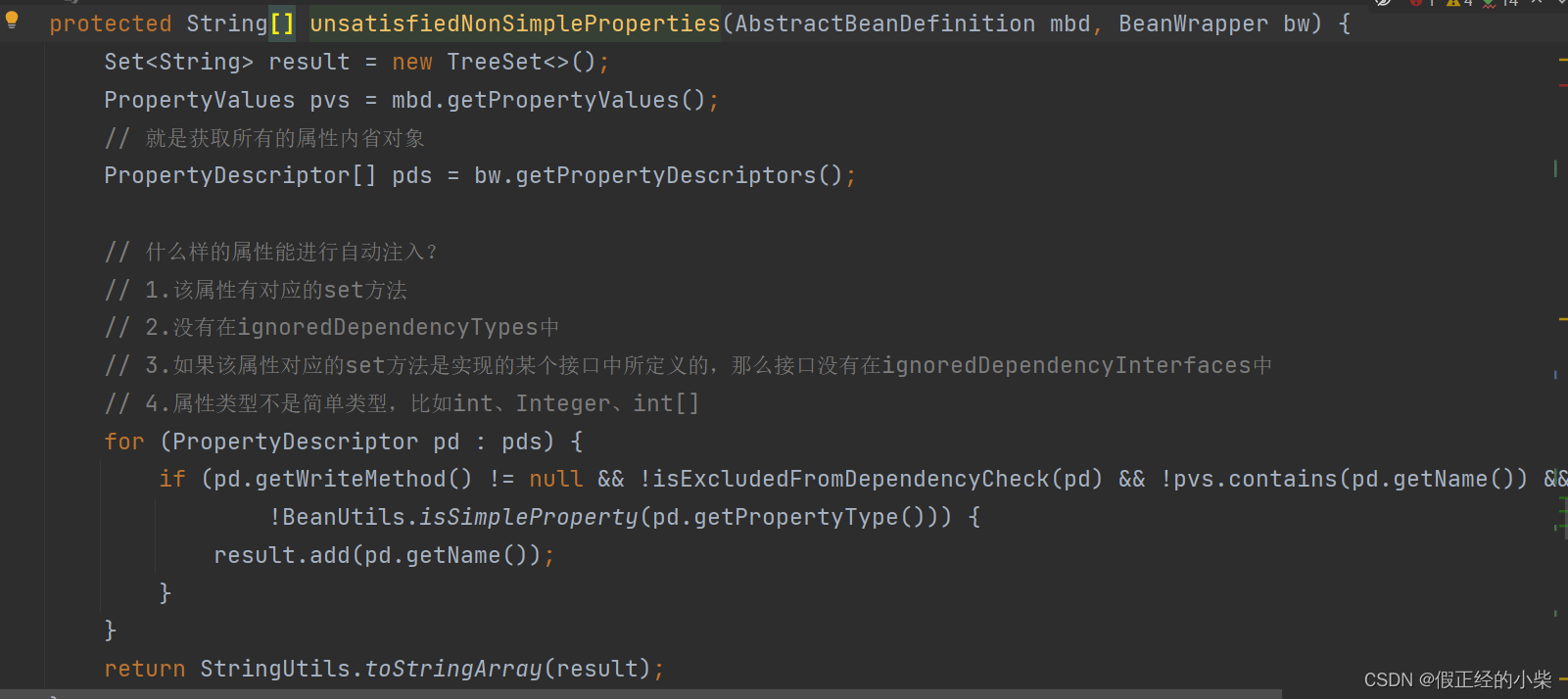
- 该属性有对应的set方法;
- 没有被 excludeFilters 所排除;
- 先前是没有填充过该属性的;
- 属性类型不是简单类型。
- 比如下面容器中有个 Number 简单类型的Bean;
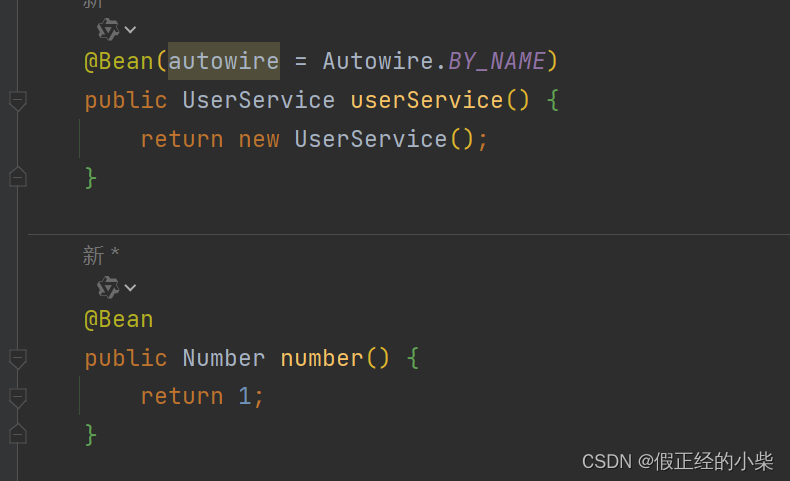
- 现在尝试注入到UserService中:
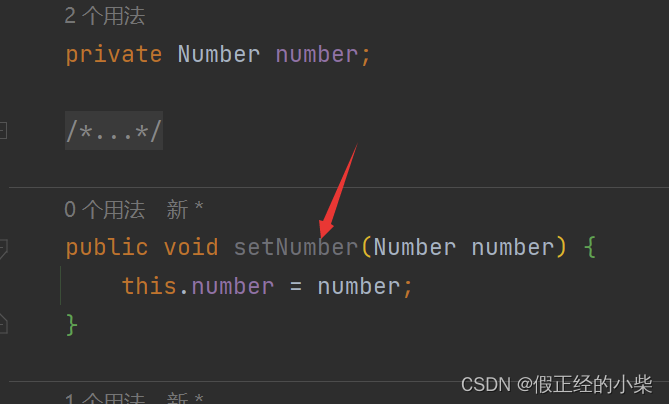
- 可以看见注入失败了

- 然后遍历返回的属性名,去获取对应的实例,然后放到 PropertyValues 对象中,由后续再直接去调用 setter 去填充。
它是有缺陷的,会把所有满足条件的 setter 方法都当做是去属性注入去调用,而且可以看见它是不让填充简单类型的实例对象的,所以就有了后续的注解式的方式。
二、@Autowired依赖注入源码分析
这里的源码逻辑和 InstantiationAwareBeanPostProcessor#postProcessPropertyValues 里实现的。其主要实现是在 AutowiredAnnotationBeanPostProcessor 中。
有必要去看一下该类的关系结构图:
 该 BeanPostProcessor 就一个无参构造,咱来看看,就是俺们希望看见的 @Autowired、@Value 注解。
该 BeanPostProcessor 就一个无参构造,咱来看看,就是俺们希望看见的 @Autowired、@Value 注解。
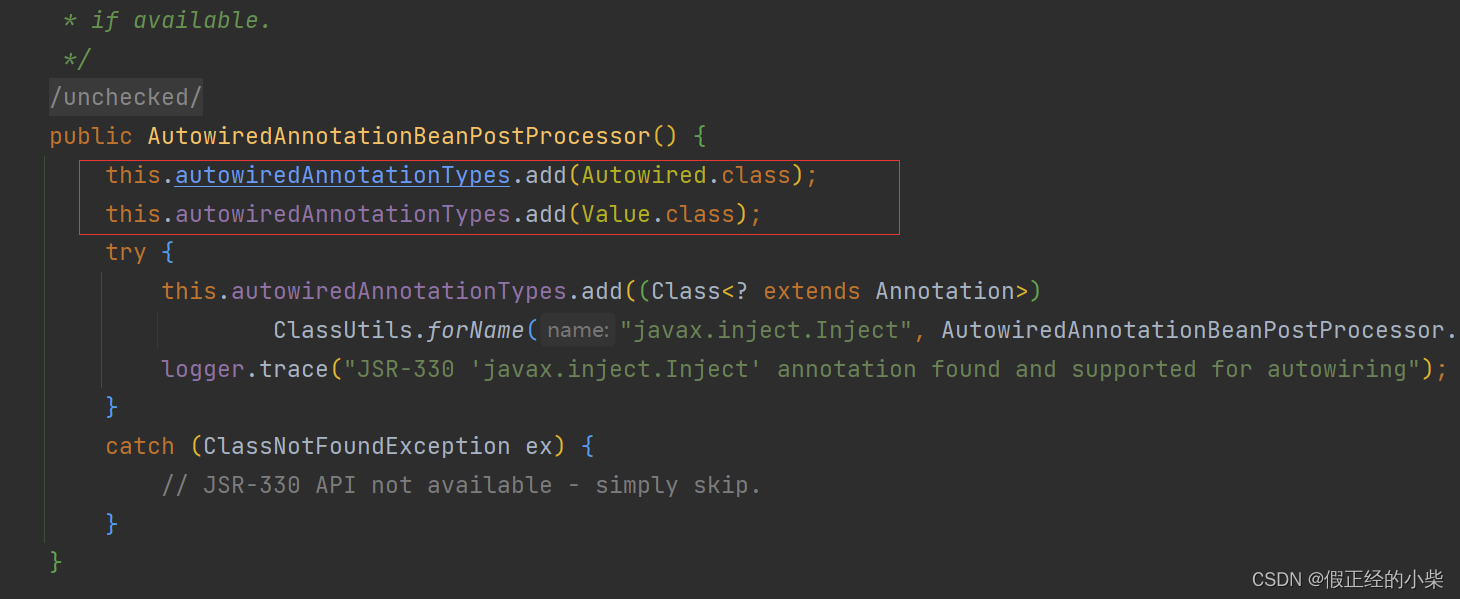 从上文中也清楚,是先执行的
从上文中也清楚,是先执行的 MergedBeanDefinitionPostProcessor#postProcessMergedBeanDefinition BeanDefinition 的再操作,再去进行属性注入。那我们看这个 BeanPostProcessor 源码,当然也是先去看 postProcessMergedBeanDefinition 方法。接下俩的分析如下:
@Override
public void postProcessMergedBeanDefinition(RootBeanDefinition beanDefinition, Class<?> beanType, String beanName) {
// 找注入点(所有被@Autowired注解了的Field或Method)
InjectionMetadata metadata = findAutowiringMetadata(beanName, beanType, null);
// 将寻找到的注入点放入到 BeanDefinition 中
metadata.checkConfigMembers(beanDefinition);
}
findAutowiringMetadata 源码分析:
private InjectionMetadata findAutowiringMetadata(String beanName, Class<?> clazz, @Nullable PropertyValues pvs) {
// Fall back to class name as cache key, for backwards compatibility with custom callers.
// 构造缓存 key,如果beanName不为空,就用beanName,否则用类的全限定名
String cacheKey = (StringUtils.hasLength(beanName) ? beanName : clazz.getName());
// Quick check on the concurrent map first, with minimal locking.
InjectionMetadata metadata = this.injectionMetadataCache.get(cacheKey);
if (InjectionMetadata.needsRefresh(metadata, clazz)) {
synchronized (this.injectionMetadataCache) {
metadata = this.injectionMetadataCache.get(cacheKey);
if (InjectionMetadata.needsRefresh(metadata, clazz)) {
if (metadata != null) {
metadata.clear(pvs);
}
// 解析注入点并缓存
metadata = buildAutowiringMetadata(clazz);
// 存入本地缓存
// 后续属性注入可以直接从这个缓存中获取
this.injectionMetadataCache.put(cacheKey, metadata);
}
}
}
return metadata;
}
也就是说咱得去看这里面的核心代码 buildAutowiringMetadata 它是如何去解析注入点的,拿到元数据然后放到本地缓存中,接下来是看源码环节:
private InjectionMetadata buildAutowiringMetadata(final Class<?> clazz) {
// 如果一个Bean的类型是String...,那么则根本不需要进行依赖注入
// 准确的说是 clazz 的全限定名是以 java. 开头,比如 java.lang.String
if (!AnnotationUtils.isCandidateClass(clazz, this.autowiredAnnotationTypes)) {
return InjectionMetadata.EMPTY;
}
List<InjectionMetadata.InjectedElement> elements = new ArrayList<>();
Class<?> targetClass = clazz;
do {
final List<InjectionMetadata.InjectedElement> currElements = new ArrayList<>();
// 遍历targetClass中的所有Field
ReflectionUtils.doWithLocalFields(targetClass, field -> {
// field上是否存在@Autowired、@Value、@Inject中的其中一个
MergedAnnotation<?> ann = findAutowiredAnnotation(field);
if (ann != null) {
// static filed不是注入点,不会进行自动注入
if (Modifier.isStatic(field.getModifiers())) {
if (logger.isInfoEnabled()) {
logger.info("Autowired annotation is not supported on static fields: " + field);
}
return;
}
// 构造注入点
boolean required = determineRequiredStatus(ann);
currElements.add(new AutowiredFieldElement(field, required));
}
});
// 遍历targetClass中的所有Method
ReflectionUtils.doWithLocalMethods(targetClass, method -> {
// 处理桥接方法
Method bridgedMethod = BridgeMethodResolver.findBridgedMethod(method);
if (!BridgeMethodResolver.isVisibilityBridgeMethodPair(method, bridgedMethod)) {
return;
}
// method上是否存在@Autowired、@Value、@Inject中的其中一个
MergedAnnotation<?> ann = findAutowiredAnnotation(bridgedMethod);
if (ann != null && method.equals(ClassUtils.getMostSpecificMethod(method, clazz))) {
// static method不是注入点,不会进行自动注入
if (Modifier.isStatic(method.getModifiers())) {
if (logger.isInfoEnabled()) {
logger.info("Autowired annotation is not supported on static methods: " + method);
}
return;
}
// set方法最好有入参
// 要是没参的话会打印日志信息,但是也会注入
if (method.getParameterCount() == 0) {
if (logger.isInfoEnabled()) {
logger.info("Autowired annotation should only be used on methods with parameters: " +
method);
}
}
boolean required = determineRequiredStatus(ann);
PropertyDescriptor pd = BeanUtils.findPropertyForMethod(bridgedMethod, clazz);
currElements.add(new AutowiredMethodElement(method, required, pd));
}
});
elements.addAll(0, currElements);
targetClass = targetClass.getSuperclass();
}
while (targetClass != null && targetClass != Object.class);
return InjectionMetadata.forElements(elements, clazz);
}
- 总结流程
- 从该类开始不断遍历父类;
- 通过反射机制遍历所有的属性
- 看属性上面是不是有 @Autowired、@Value、@Inject 中的其中一个
- 排除属性是静态的,静态的属性类方面的成员,不属于实体级别的,不应该进行属性注入;
- 创建注入点
AutowiredFieldElement实体对象,然后放入到InjectedElement集。
- 通过反射机制遍历所有的方法
- 其他点和上面属性是一样的,如看方法上有无那些注解,排除方法是静态的…
- 然后创建注入点
AutowiredMethodElement实体对象,然后放入到InjectedElement集。
OK,也就是通过这咱就拿到了需要注入的属性和方法集,接下来就可以进行注入咯。
现咱去看看 InstantiationAwareBeanPostProcessor#postProcessPropertyValues ,这里指的是 AutowiredAnnotationBeanPostProcessor#postProcessPropertyValues
@Override
public PropertyValues postProcessProperties(PropertyValues pvs, Object bean, String beanName) {
// 找注入点(所有被@Autowired注解了的Field或Method)
InjectionMetadata metadata = findAutowiringMetadata(beanName, bean.getClass(), pvs);
try {
metadata.inject(bean, beanName, pvs);
} catch (BeanCreationException ex) {
throw ex;
} catch (Throwable ex) {
throw new BeanCreationException(beanName, "Injection of autowired dependencies failed", ex);
}
return pvs;
}
- findAutowiringMetadata 方法找到对应需要注入的元数据对象,上面分析过,这里就是从本地缓存拿到的 InjectionMetadata 对象;
- 接下来直接进行注入~
注入 inject 方法实现其实很简单,就是遍历 InjectedElement 对象,然后依次调用它的 inject 进行遍历。
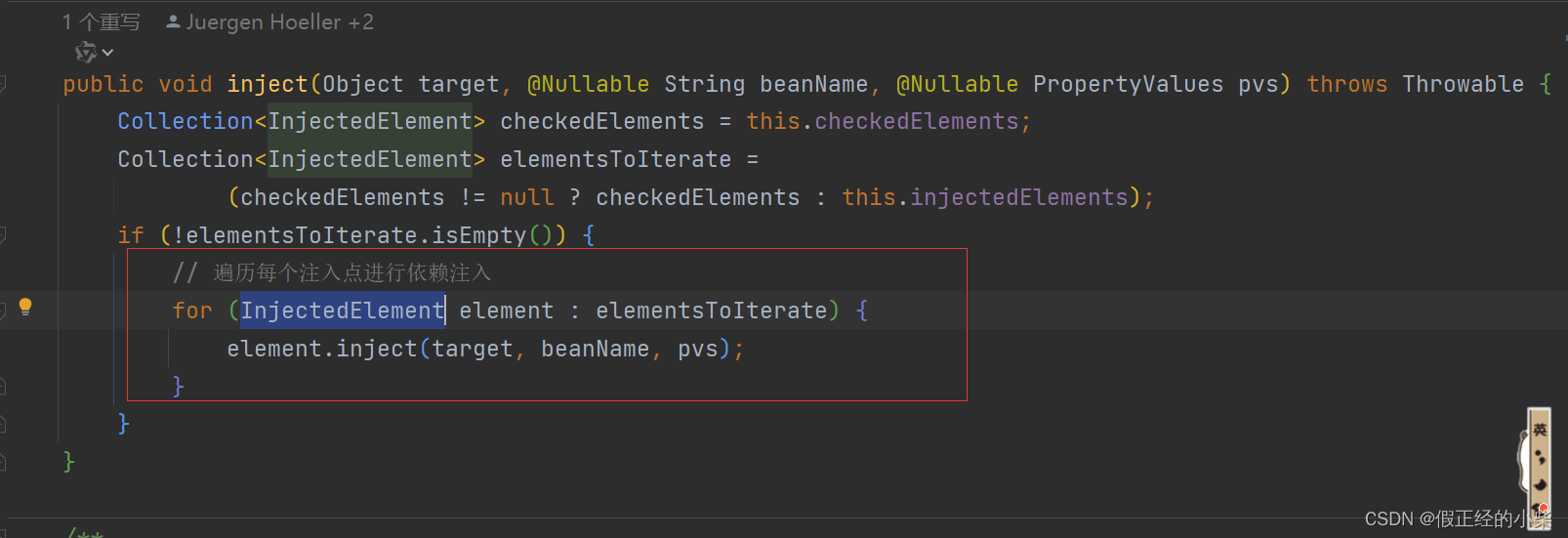
咱再过来看看 AutowiredFiledElement、AutowiredMethodElement、InjectedElement 之间的关系:

接下来就是看属性注入和方法注入是咋地实现的咯~
属性注入源码分析(AutowiredFieldElement.inject)
@Override
protected void inject(Object bean, @Nullable String beanName, @Nullable PropertyValues pvs) throws Throwable {
Field field = (Field) this.member;
Object value;
if (this.cached) {
// 对于原型Bean,第一次创建的时候,也找注入点,然后进行注入,此时cached为false,注入完了之后cached为true
// 第二次创建的时候,先找注入点(此时会拿到缓存好的注入点),也就是AutowiredFieldElement对象,此时cache为true,也就进到此处了
// 注入点内并没有缓存被注入的具体Bean对象,而是beanName,这样就能保证注入到不同的原型Bean对象
try {
value = resolvedCachedArgument(beanName, this.cachedFieldValue);
} catch (NoSuchBeanDefinitionException ex) {
// Unexpected removal of target bean for cached argument -> re-resolve
value = resolveFieldValue(field, bean, beanName);
}
} else {
// 根据filed从BeanFactory中查到的匹配的Bean对象
value = resolveFieldValue(field, bean, beanName);
}
// 反射给filed赋值
if (value != null) {
ReflectionUtils.makeAccessible(field);
field.set(bean, value);
}
}
- resolveFieldValue 方法,从 BeanFactory 中查询到对应的 Bean 对象;
- 反射进行属性赋值
方法注入源码分析(AutowiredMethodElement.inject)
@Override
protected void inject(Object bean, @Nullable String beanName, @Nullable PropertyValues pvs) throws Throwable {
// 如果pvs中已经有当前注入点的值了,则跳过注入
if (checkPropertySkipping(pvs)) {
return;
}
Method method = (Method) this.member;
Object[] arguments;
if (this.cached) {
try {
arguments = resolveCachedArguments(beanName);
} catch (NoSuchBeanDefinitionException ex) {
// Unexpected removal of target bean for cached argument -> re-resolve
arguments = resolveMethodArguments(method, bean, beanName);
}
} else {
arguments = resolveMethodArguments(method, bean, beanName);
}
if (arguments != null) {
try {
ReflectionUtils.makeAccessible(method);
method.invoke(bean, arguments);
} catch (InvocationTargetException ex) {
throw ex.getTargetException();
}
}
}
- 排除掉 PropertyValues 已经有过的注入点,因为在上述提到过,是先进行的@Autowired 注入,然后再去 PropertyValues 的注入;(我不知道为啥属性注入那为什么不先排除,再看注不注入)
- resolveMethodArguments 找各个参数的对象;
- 反射调用对应的方法。
流程图
这篇已经很长了,现在只是阐述到根据注入点类型找 Bean,如何实现通过注入点类型找 Bean 还没阐述,再写下一篇博客进行阐述,都放这篇可能太长了。
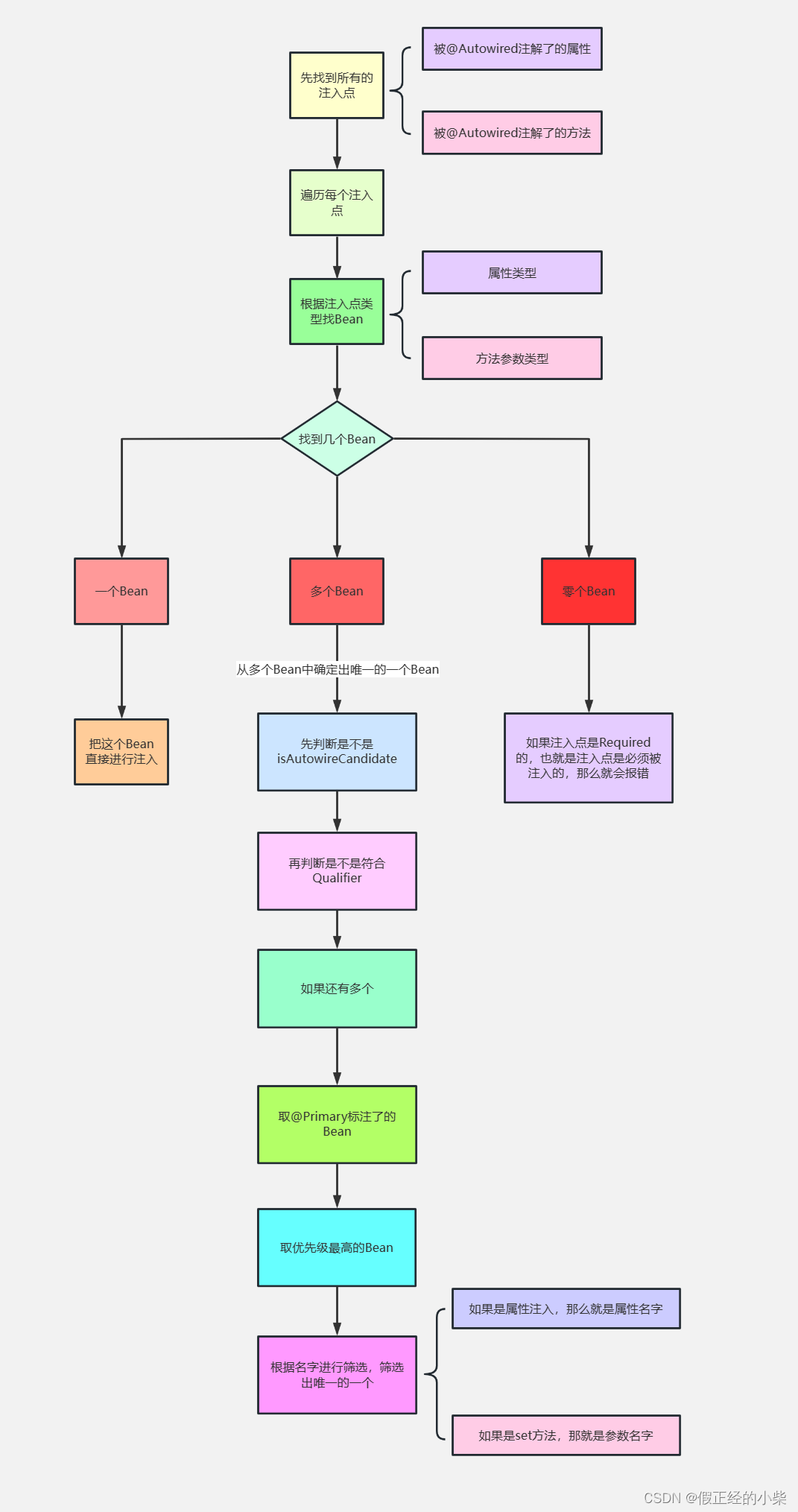
本文来自互联网用户投稿,该文观点仅代表作者本人,不代表本站立场。本站仅提供信息存储空间服务,不拥有所有权,不承担相关法律责任。 如若内容造成侵权/违法违规/事实不符,请联系我的编程经验分享网邮箱:chenni525@qq.com进行投诉反馈,一经查实,立即删除!
- Python教程
- 深入理解 MySQL 中的 HAVING 关键字和聚合函数
- Qt之QChar编码(1)
- MyBatis入门基础篇
- 用Python脚本实现FFmpeg批量转换
- 如何用GOWIN创建FPGA工程
- 在laravel 项目中 composer.json 中 autoload 配置是什么作用
- OpenAI GPT应用商城正式上线!超300万个GPT应用供选择
- Springboot数据加密篇
- 让测试人头疼的web自动化之验证码识别彻底解决方案
- 关于gcc版本问题导致找不到filesystem以及GCC多版本切换
- C++-UI入门
- ensp与HCL共存问题
- python实现一维傅里叶变换——冈萨雷斯数字图像处理
- jssip挂断事件(ended),通话结束判断主叫挂断、被叫挂断还是系统挂断

